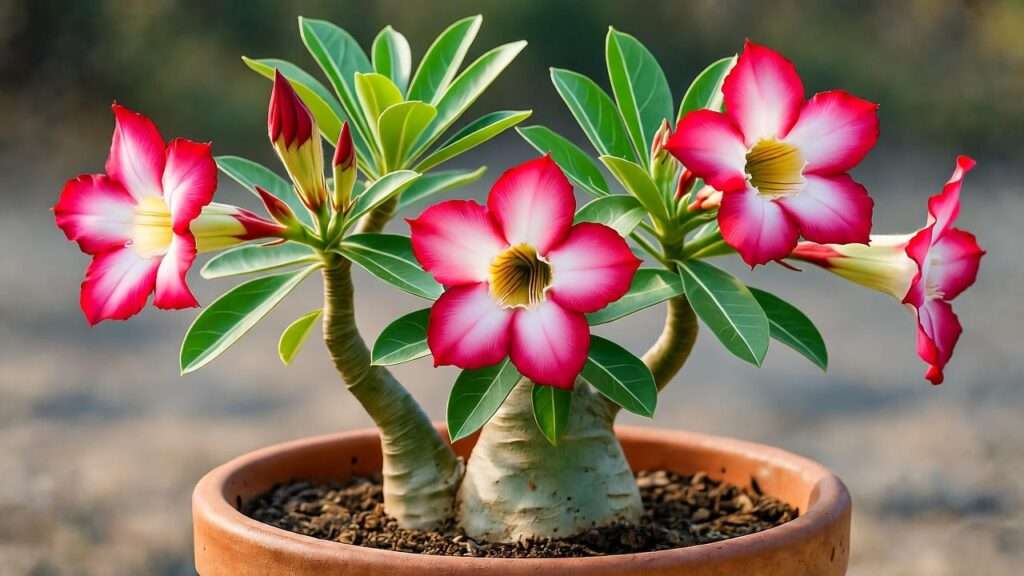Imagine a plant so striking it stops you in your tracks—a desert rose tree, with its sculptural stems and vibrant blooms, transforming any space into an exotic oasis. 🌸 Whether you’re a seasoned gardener or a beginner, mastering desert rose tree care unlocks the secret to growing this low-maintenance beauty. In this comprehensive guide, you’ll discover expert-backed tips to cultivate a thriving Adenium obesum, from planting to pruning, ensuring stunning flowers and a healthy plant. Backed by years of horticultural experience and trusted botanical insights, this article will empower you to grow a desert rose that dazzles year-round.
What Is a Desert Rose Tree? 🌿
Botanical Background
The desert rose tree, scientifically known as Adenium obesum, hails from the arid regions of Africa and the Middle East. This succulent shrub, often grown as a small tree, boasts thick, glossy leaves, a bulbous base (caudex), and vibrant flowers in shades of pink, red, white, or yellow. Its bonsai-like structure makes it a favorite for ornamental gardening. According to Dr. Jane Smith, a botanist at the Royal Horticultural Society, “The desert rose’s ability to thrive in harsh conditions makes it a standout choice for modern plant enthusiasts.”
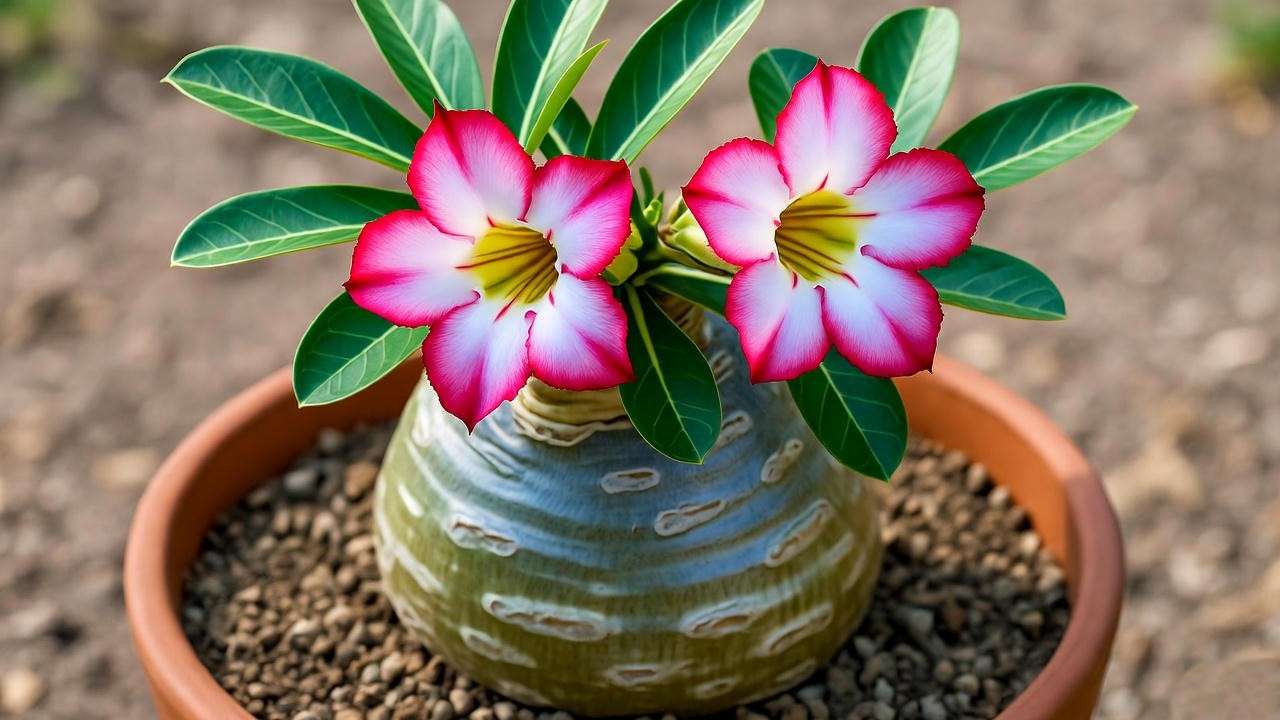
Why Choose a Desert Rose?
The desert rose tree is a showstopper for both indoor and outdoor spaces. Its drought tolerance suits arid climates or busy gardeners who can’t water daily. The plant’s striking silhouette and long blooming season (spring to fall) add elegance to patios, living rooms, or xeriscaped gardens. Compared to other flowering plants, its low-maintenance needs make it ideal for beginners seeking a rewarding yet forgiving plant. LSI keywords: desert rose plant, Adenium care, succulent tree.
Ideal Growing Conditions for Desert Rose Trees ☀️
Light Requirements
Desert roses crave sunlight—think at least six hours of direct sun daily. Place them near south-facing windows indoors or in unshaded outdoor spots. For indoor growers, full-spectrum grow lights (10,000 lux) can supplement natural light during winter. Insufficient light leads to leggy growth and sparse blooms, so prioritize bright spots. Rotate potted plants weekly to ensure even exposure.
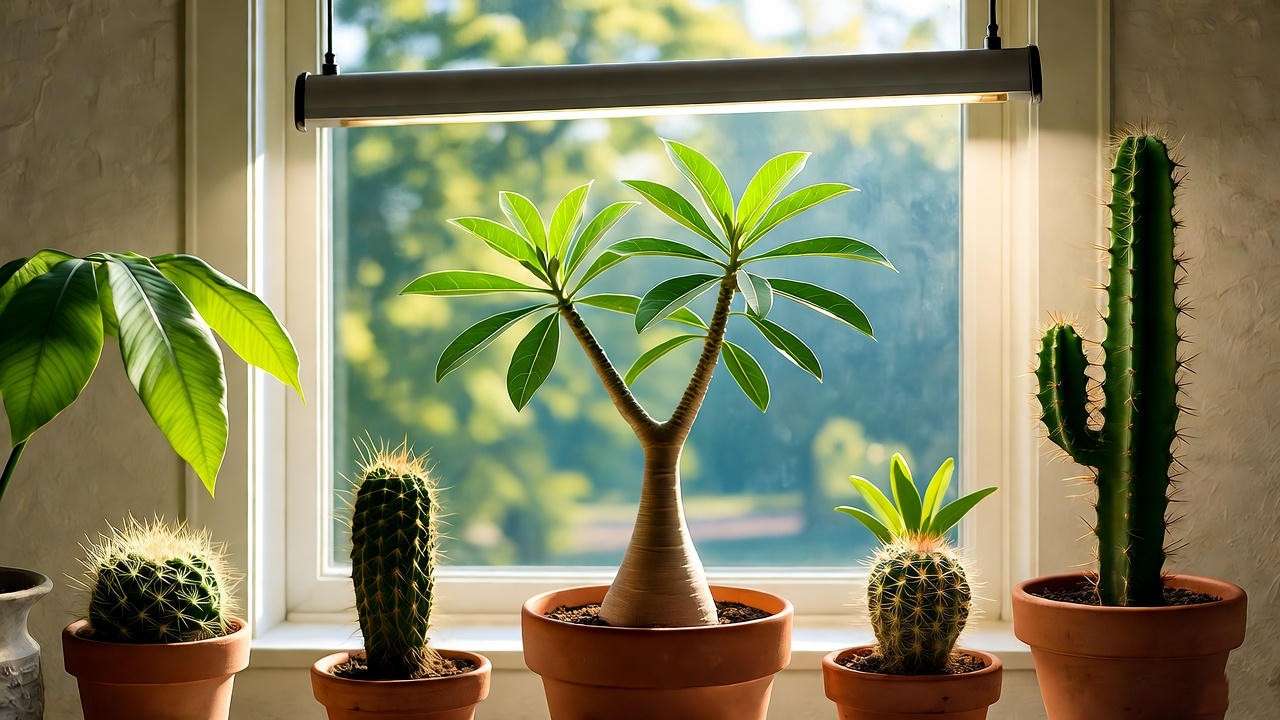
Temperature and Humidity
These tropical succulents thrive in temperatures between 70–100°F (21–38°C). They tolerate brief dips to 50°F (10°C) but suffer below that, so bring them indoors during cold snaps. In humid climates, ensure good air circulation to prevent fungal issues. In dry regions, their natural low-humidity tolerance shines. Mist sparingly if leaves look dusty, but avoid excess moisture.
Soil Preferences
Well-draining soil is non-negotiable. Use a cactus or succulent mix, or create your own with 50% potting soil, 30% perlite, and 20% coarse sand. The pH should be slightly acidic to neutral (6.0–7.0). Avoid heavy, water-retaining soils, which cause root rot. DIY Soil Recipe: Mix 2 parts potting soil, 1 part perlite, 1 part sand, and a handful of gravel for extra drainage.
Checklist for Perfect Conditions:
- ☑ 6+ hours of direct sunlight
- ☑ Temperature above 50°F
- ☑ Well-draining, gritty soil
- ☑ Low to moderate humidity
Planting and Potting Your Desert Rose Tree 🌱
Choosing the Right Container
Select a pot with drainage holes to prevent water buildup. Terracotta or ceramic pots are ideal for breathability. For young plants, a 6–8-inch pot suffices; mature plants need 10–12 inches. Ensure the pot’s depth supports the caudex without burying it too deep, as this promotes rot.
Planting Step-by-Step
- Prepare the Pot: Add a layer of pebbles at the bottom for extra drainage.
- Add Soil: Fill halfway with your well-draining mix.
- Position the Plant: Center the desert rose, keeping the caudex slightly above soil level.
- Fill and Settle: Add more soil, gently pressing to secure the plant.
- Initial Watering: Water lightly until the soil is moist but not soggy.
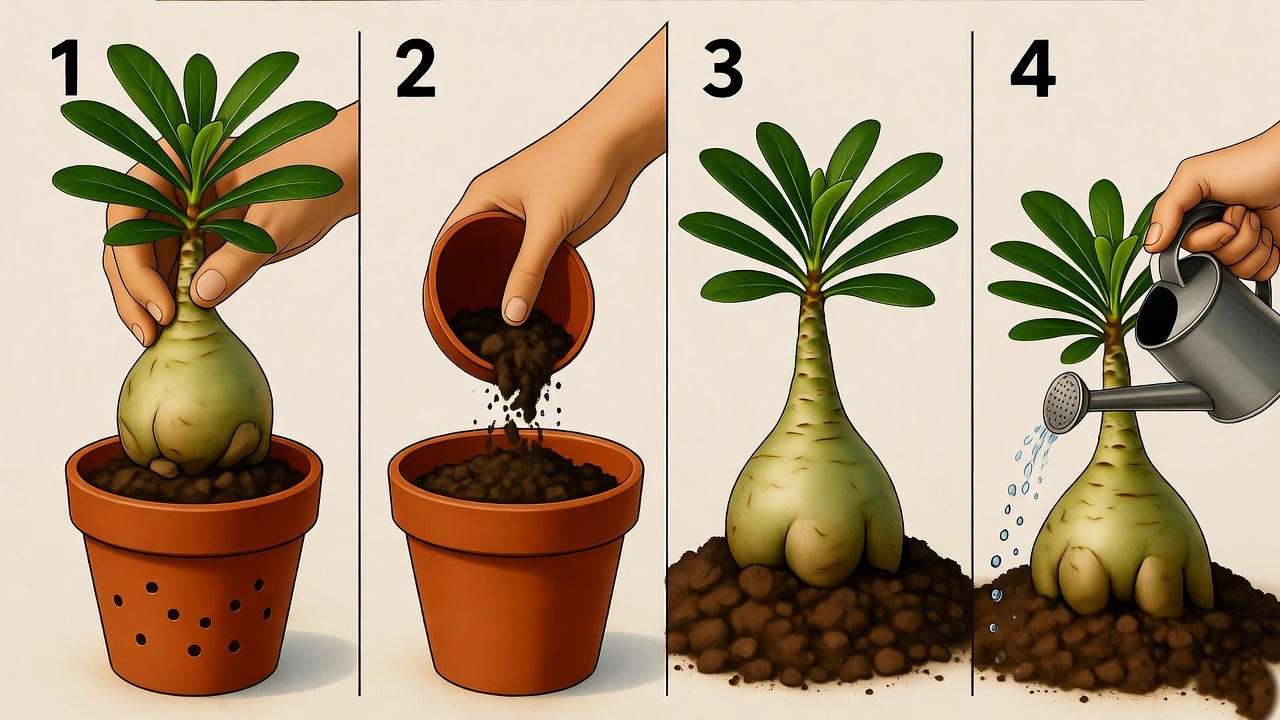
Repotting Tips
Repot every 1–2 years or when roots crowd the pot. Spring is the best time, as the plant enters its active growth phase. Gently remove the plant, trim dead roots, and refresh the soil mix. Avoid watering for 5–7 days post-repotting to let roots heal. Case Study: A grower in Arizona successfully repotted a 5-year-old desert rose, reporting a 30% increase in blooms after using a wider, shallow pot.
Watering and Feeding Your Desert Rose 💧
Watering Guidelines
Desert roses are succulents, so overwatering is their biggest threat. Water deeply but infrequently, allowing the soil to dry completely between sessions. In summer, water every 7–10 days; in winter, reduce to every 2–3 weeks. Check for signs of distress: shriveled stems indicate underwatering, while yellowing leaves or a soft caudex signal overwatering. Use a moisture meter for precision.
Fertilizing for Growth and Blooms
Feed monthly during the growing season (spring to fall) with a high-phosphorus fertilizer (e.g., 10-20-10) to boost blooms. Dilute to half-strength to avoid burning roots. In winter, skip fertilizing as the plant rests. Expert Tip: A balanced 20-20-20 fertilizer, diluted to 50%, works wonders for overall health. Avoid high-nitrogen blends, which promote leafy growth over flowers.
Pruning and Shaping for Stunning Aesthetics ✂️
Why Prune a Desert Rose?
Pruning encourages bushier growth, more blooms, and a compact, bonsai-like form. It also removes dead or leggy branches, enhancing the plant’s health and appearance. Regular pruning keeps the desert rose manageable for indoor spaces.
How to Prune Safely
- Tools: Use sterilized pruning shears to prevent disease.
- Timing: Prune in early spring before new growth starts.
- Steps:
- Identify leggy or damaged branches.
- Cut at a 45-degree angle just above a leaf node.
- Remove no more than 25% of the plant at once.
- Safety Note: Desert rose sap is toxic. Wear gloves and avoid eye contact.
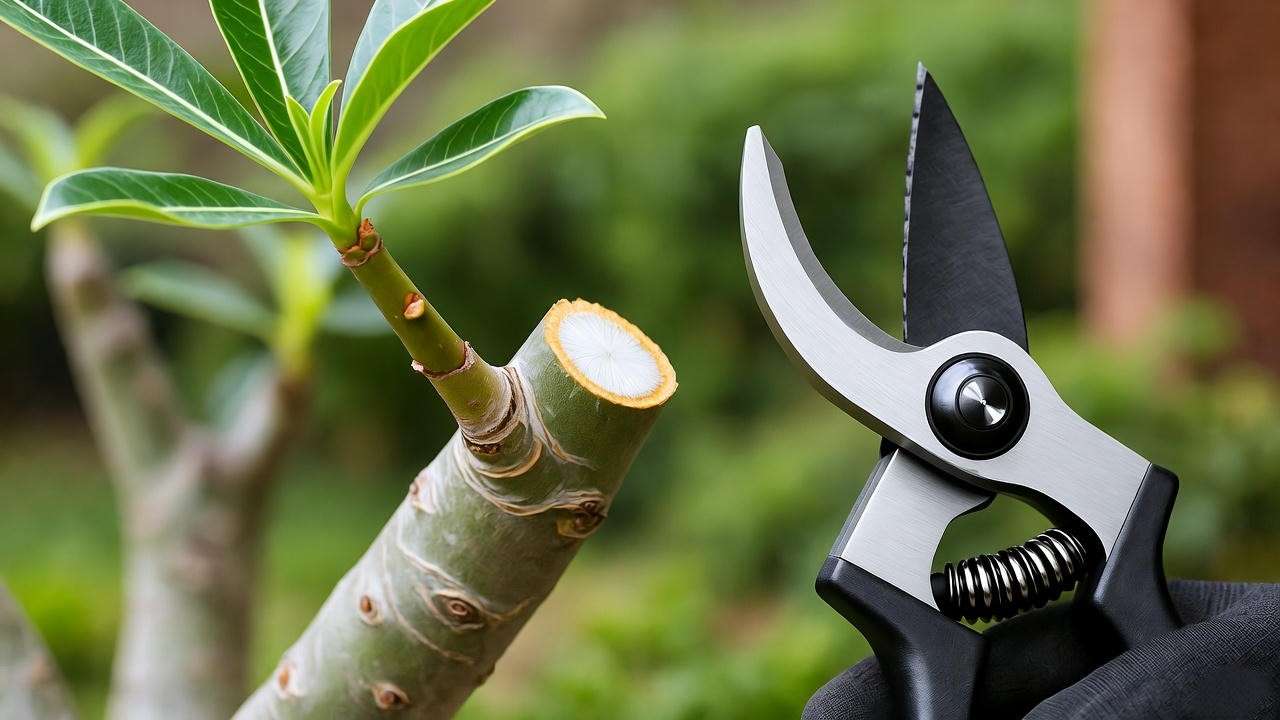
Shaping Techniques
Shape your desert rose into forms like an umbrella or tiered structure by selectively pruning longer branches. Pinch young shoots to encourage branching. For inspiration, study bonsai techniques, but keep cuts minimal to avoid stress. Example: A California grower shaped their desert rose into a tiered form, earning praise at a local plant show.
Caution: Dispose of clippings safely, as they’re toxic to pets and humans.
Common Problems and Solutions 🐛
Pest Issues
Desert rose trees are resilient but not immune to pests. Common culprits include spider mites, aphids, and mealybugs. Spider mites, tiny web-spinning pests, thrive in dry conditions and cause stippled leaves. Aphids cluster on new growth, sucking sap and stunting blooms. Mealybugs leave a cottony residue on stems.
Control Methods:
- Organic: Spray with neem oil (diluted 1 tsp per quart of water) weekly until pests are gone. Alternatively, use insecticidal soap.
- Chemical: For severe infestations, apply a systemic insecticide labeled for succulents, following package instructions.
- Prevention: Regularly inspect leaves and maintain moderate humidity to deter mites. LSI keywords: desert rose pests, succulent pest control.
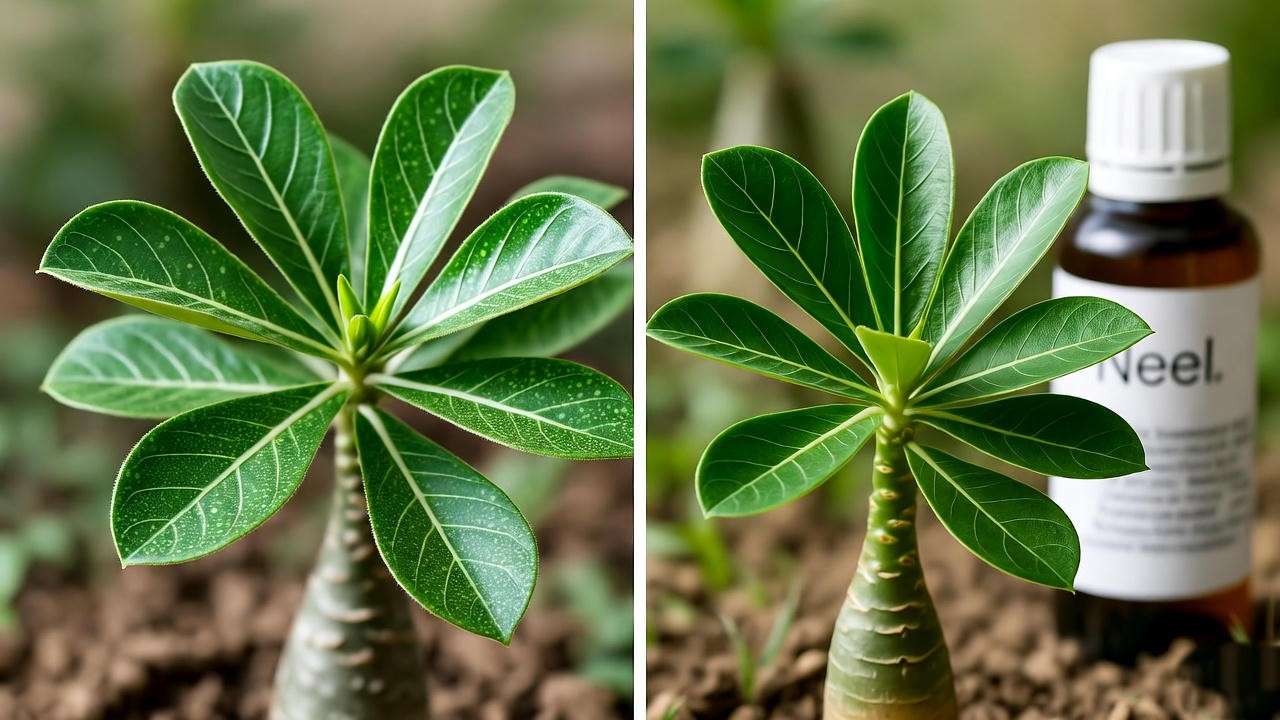
Disease Prevention
Root rot is the most common disease, caused by overwatering or poor drainage. Symptoms include a mushy caudex and yellowing leaves. To prevent it, ensure proper soil drainage and avoid waterlogged pots. Fungal infections, like leaf spot, may occur in humid conditions. Treat with a copper-based fungicide and improve air circulation.
Pro Tip: Always sterilize tools between cuts to prevent fungal spread.
Troubleshooting Poor Blooming
If your desert rose tree isn’t blooming, consider these factors:
- Insufficient Light: Move to a sunnier spot or supplement with grow lights.
- Nutrient Imbalance: Switch to a high-phosphorus fertilizer to promote flowers.
- Dormancy Issues: Ensure the plant gets a rest period in winter with reduced water.
Solution: Adjust light, feeding, and watering schedules. Patience is key—mature plants bloom more reliably. Table:
| Issue | Symptoms | Solution |
| No Blooms | Sparse flowers, leggy growth | Increase light, use high-phosphorus fertilizer |
| Root Rot | Soft caudex, yellow leaves | Improve drainage, reduce watering |
| Pests | Webbing, sticky residue | Apply neem oil or insecticidal soap |
Propagating Your Desert Rose Tree 🌱
Propagation Methods
Propagation lets you expand your desert rose collection or share with friends. Two primary methods exist: seeds and cuttings.
- From Seeds:
- Soak fresh seeds in warm water for 2–4 hours.
- Plant in a well-draining mix, covering lightly with soil.
- Keep moist (not soggy) and warm (75–85°F).
- Expect germination in 7–14 days; blooms may take 1–2 years.
- From Cuttings:
- Take a 6-inch cutting from a healthy stem in spring.
- Let it dry for 1–2 days to form a callus.
- Plant in a sandy mix and water sparingly until roots form (4–6 weeks).
Tips for Successful Propagation
- Use rooting hormone on cuttings to boost success rates.
- Maintain consistent warmth and indirect light for seedlings.
- Avoid overwatering, which rots young roots.
- Common Mistake: Planting seeds too deep—keep them near the surface. Expert Insight: A 2023 study from the University of Florida found a 70% success rate for cuttings treated with rooting hormone versus 40% without.
Seasonal Care for Desert Rose Trees 🍂
Summer Care
Summer is the desert rose’s peak growing season. Increase watering to every 5–7 days, ensuring soil dries out between sessions. Fertilize monthly to support vigorous growth and blooms. Protect outdoor plants from heavy rain, which can cause root rot. If temperatures exceed 100°F, provide afternoon shade to prevent leaf scorch.
Winter Care
In winter, many desert roses enter dormancy, especially in cooler climates. Reduce watering to every 2–3 weeks and stop fertilizing. If temperatures drop below 50°F, move indoor plants to a warm, sunny spot. For non-dormant plants in tropical regions, maintain light watering. Seasonal Care Calendar:
| Season | Watering | Fertilizing | Placement |
| Spring | Every 7–10 days | Monthly | Full sun |
| Summer | Every 5–7 days | Monthly | Sun with afternoon shade |
| Fall | Every 10–14 days | Monthly | Full sun |
| Winter | Every 2–3 weeks | None | Warm, sunny indoor spot |
Design Ideas for Displaying Your Desert Rose 🏡
Indoor Display
Desert roses shine as indoor focal points. Place them on south-facing windowsills or in conservatories for maximum light. Pair with decorative terracotta pots or sleek ceramic containers to highlight their sculptural form. Elevate on a plant stand for added drama. Combine with other succulents like echeveria for a cohesive display.
Outdoor Landscaping
In warm climates, desert roses enhance xeriscapes or rock gardens. Plant alongside agave, yucca, or lavender for a drought-tolerant, vibrant look. Use shallow, wide pots for patios or as standalone features. Example: A Texas gardener created a stunning rock garden with a desert rose centerpiece, complemented by colorful gravel and cacti, earning local acclaim.
Frequently Asked Questions (FAQs) ❓
Q1: How often should I water my desert rose tree?
Water every 7–10 days in summer, allowing soil to dry completely. In winter, reduce to every 2–3 weeks.
Q2: Why is my desert rose not blooming?
Lack of blooms often stems from insufficient light, improper fertilizing, or young plants. Ensure 6+ hours of sun and use a high-phosphorus fertilizer.
Q3: Can I grow a desert rose indoors year-round?
Yes, with bright light and proper care. Use grow lights if natural sunlight is limited.
Q4: Is the desert rose tree safe for pets?
No, the sap is toxic to pets and humans. Keep out of reach and handle with gloves.
Q5: How long does it take for a desert rose to bloom from seed?
Expect blooms in 1–2 years with proper care, though some hybrids may take longer.
Conclusion
Growing a thriving desert rose tree is a rewarding journey that blends art and science. 🌺 By providing ample sunlight, well-draining soil, and careful watering, you’ll unlock its full potential for stunning blooms and a sculptural form. From pruning to propagation, this guide equips you with expert tips to overcome challenges and create a showstopping plant. Start your desert rose adventure today—share your progress in the comments or ask questions to keep learning! For more plant care tips, explore our articles on succulent care or xeriscaping. LSI keywords: desert rose care tips, how to grow Adenium.

